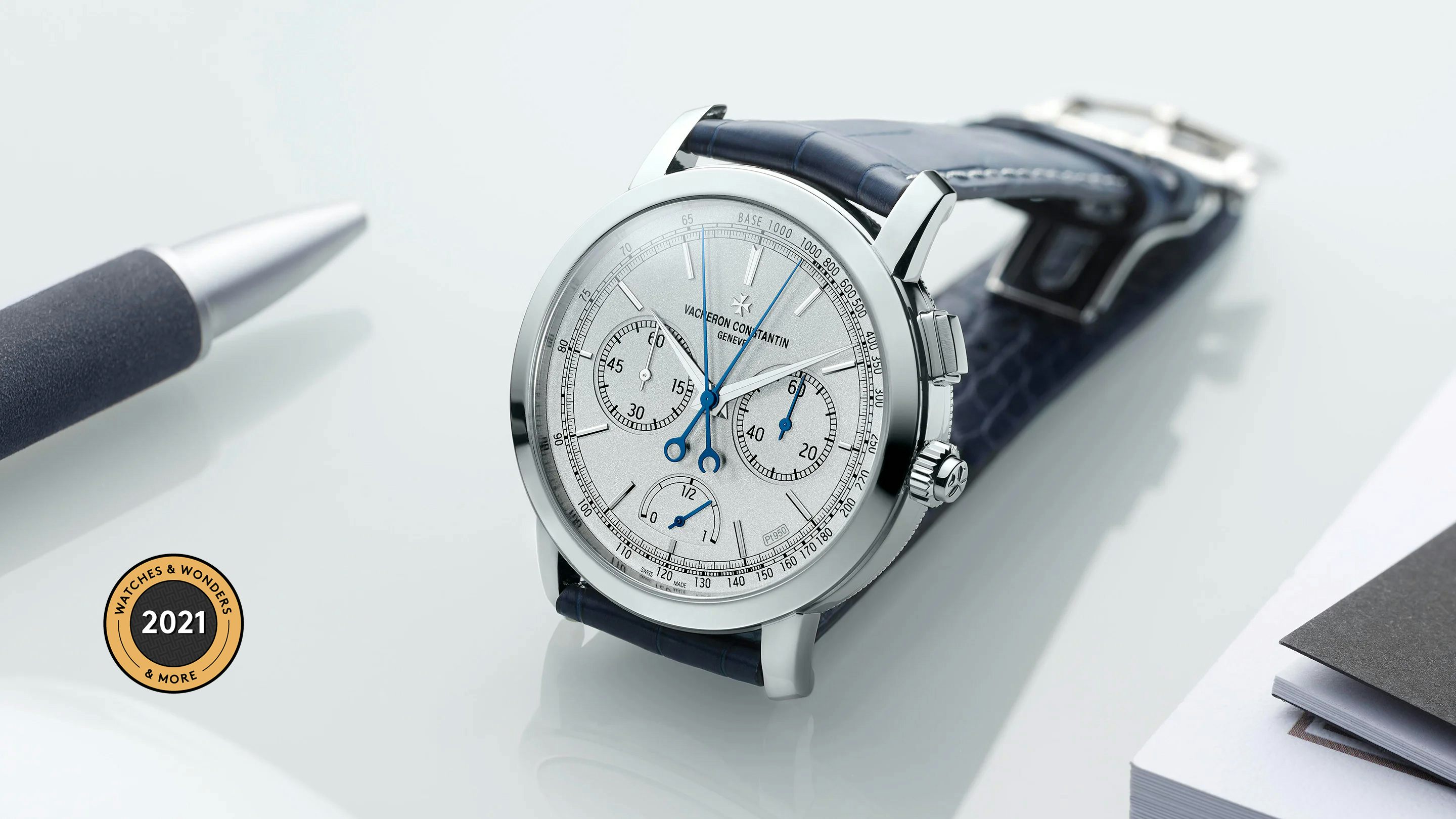ADVERTISEMENT

ADVERTISEMENT
If you've followed Vacheron Constantin for any length of time, you might be aware of the automatic rattrapante caliber 3500 – and then again, you might not. It's an exotic caliber: A peripheral rotor, split-seconds self-winding movement, finished to within an inch of its life and with several new-to-the-caliber technical innovations as well. If you're a movement geek, you're probably salivating at the very idea, but chances are good that you either haven't heard about it, or forgot that you have – Vacheron used it exactly once, in 2015, in the Harmony Ultra-Thin Grande Complication Chronograph.
After a lengthy hiatus, the maison's brought it back in another limited edition watch – but one which in design and overall feel stays much closer to a traditional notion of watchmaking than the Harmony case.
Say hello to Collection Excellence Platine (sounds expensive already, right?) Traditionnelle Split-Seconds Chronograph Ultra-Thin – quite possibly the most beautiful piece of classic watchmaking at Watches & Wonders and one of the most heart-stoppingly lovely timepieces anywhere right now, period.
Now you look at this piece next to the Harmony, and if your heart beats faster for classic design, it's not really a contest. The Harmony was not a bad-looking watch, not by any means, and Vacheron throughout its history has often gone for more unusual case shapes (and it's not as if a cushion case is going to get you stuck in the horological equivalent of the Salon des Refusés either). But there is something undeniably seductive about putting a rattrapante chronograph – especially one with a movement that lives and dies by the execution of its finish – in a round platinum case. It just feels right – in the same way that Romanée-Conti probably tastes just swell out of a highball glass, but simply feels more correct in a big ol' proper wine glass.
The Excellence Platine Collection is a great place to find this movement. Excellence Platine is actually a sub-category of the Traditionelle watches, which, while they do not look back at any particular vintage model (that's what Les Historiques is for) nonetheless are intended to represent traditional high-end Genevan and Swiss watchmaking, combined when appropriate with modern technical solutions. This is exactly what you get with the caliber 3500, and with this watch. It's a monopusher, split-seconds design, but with some technical refinements to the movement which put it out in front of some more conservatively engineered split-seconds calibers from the days of yore.
While calling a rattrapante chronograph a "Grande Complication," as Vacheron did in 2015, is slightly at odds with what the term meant historically (usually the term is reserved for a watch with a rattrapante chronograph, repeater, and perpetual calendar), it is not bad in terms of conveying that a split-seconds chronograph is considered a high complication – and why the perpetual calendar and minute repeater are its peers. A split-seconds mechanism requires a precise interaction between a number of parts and includes the coordination of the action of two column wheels, as well as the mechanism for "splitting" the two seconds hands.
A split-seconds chronograph is one with two seconds hands. These run together – one superimposed over the other – until you push the "split" button (found, in this case, at 2:00). This stops one hand, but allows the other to continue running. The function allows you to do things like record successive lap times accurately. The split mechanism itself is at the center of the movement – below, you can see the pincers that fall on the wheel for the split-seconds hand, freezing it in place. When the pincers release the wheel, a spring-actuated cam and roller system (the roller is usually ruby) causes the split-seconds hand to flick back into place with the still-running seconds hand. The entire mechanism is very light in action and requires great care to adjust properly, as the two seconds hands need to be exactly superimposed. To work properly, the hands also need to be as light and thin as possible, compounding the challenge.
We mentioned that the caliber 3500 comes with some extra goodies technically, in comparison to other split-seconds movements. The most obvious of these is the automatic winding system. Cal. 3500 uses a peripheral rotor – most gearhead enthusiasts will remember that such systems are inherently less efficient in terms of transmitting rotational energy to the winding train than a more traditional center-mounted rotor system. They are therefore relatively rare (although more common today than they have ever been historically), and generally, they are not found in split-seconds chronographs thanks to the difficulty involved in fitting one over the chronograph mechanism. Peripheral winding systems offer another advantage as well, which is an unobstructed view of the movement, and when a movement is this lovely, you definitely want as few obstructions as possible to seeing it in action.
ADVERTISEMENT
The clutch system for the chronograph also uses a design unique to VC – it's a lateral clutch mechanism, but with a friction-coupled driving wheel. The idea here is to offer the advantages of a friction-coupled vertical clutch – that is, no stuttering of the chronograph seconds hand when the user starts the chronograph – while still retaining the aesthetics of a lateral clutch system.
Notable also is the 60 minute counter (up from the 30 minute counter more usually found) as well as the power reserve indication (the power reserve for cal. 3500 is 48 hours).
The only downside to the design overall is that it is somewhat on the large size – not in thickness, but in diameter. The movement is only 5.2mm thick but it is also 37.66mm in diameter, or about 16 3/4 lignes – closer to the size you'd expect in a smaller pocket watch movement, which in addition to the cost, complexity, and exclusivity of the caliber, may have something to do with why Vacheron has not used it more generally throughout its collections (albeit such a movement is never going to be in large series production under any circumstances). As a result, the entire watch, while quite flat, is slightly larger in diameter than you might guess from its design, at 10.72mm x 42.5mm. Vacheron, in any case, describes the watch as having an "imposing" presence, and I see no reason to dispute the characterization – perhaps the retro-grouch in me would have preferred something under 40mm but the watch looks like a show-stopper no matter how you slice it.
A classically finished, platinum rattrapante self-winding chronograph, with power reserve, peripheral winding system (with 22k gold rotor, naturellement), and some innovative technical bells and whistles may sound like an expensive and exclusive proposition. And if that's the impression you got, you're right – Vacheron is making ten of these babies, and the price is $288,000. That's par for the course for this sort of thing, however. A close competitor is Patek Philippe's 5370P, which is a hand-wound platinum rattrapante chrono – slightly less classic in some details; it's a two-pusher rather than a monopusher design – and which retails at the moment for $274,410. That's a 41mm x 13.56mm watch as well, so the Vacheron, despite the larger diameter of the movement (the caliber CHR 29‑535 PS in the Patek is 29.6mm in diameter) is not significantly larger than the 5370, when all is said and done.
I want to see watches like this in person rather the same way I imagine that a car journalist would love to have a day at the track with...well, I'm not sure what. The automotive equivalent would have to be something that has all the charm and clarity of design of, say, a mid-century sports car from Aston Martin (the watch would not look out of place on a wrist draped languidly over the wheel of a DB-2) but with a modern engine, and certainly a modern clutch.
One wonderful thing about haute horlogerie watchmaking is that we can still see mechanical innovation combined with traditional hand-finishing and classic design which has stood the test of time. There would be nothing that a watchmaker from 1950 wouldn't understand about the Split-Seconds Chronograph Ultra-Thin, but there would be much they would admire and find fascinating. A watch like this is at least as much a cultural artifact as it is anything else – a statement piece, but not one merely of affluence, but also of the retention and nurturing of the methods and values that have made Vacheron a continued success, after more than a quarter millennium.
The Vacheron Constantin Collection Excellence Platine Split-Seconds Chronograph Ultra-Thin, Ref: 5400T/000P-B637:
Case, 950 platinum 42.5 mm diameter, 10.72 mm thick, transparent sapphire crystal caseback. Water-resistance tested at a pressure of 3 bar (approx. 30 meters). Dial, platinum with tachymetric scale.
Movement, cal. 3500, peripheral rotor in 22k gold; 37.66mm x 5.2mm, with 48-hour power reserve, running in 47 jewels at 21,600 vph. Geneva Hallmark certified. Split-seconds, with dragging 60 minute counter and lateral friction clutch.
Strap, blue alligator, with platinum and silk stitching, and platinum buckle.
Limited edition of 15 pieces worldwide; price, $288,000.
Shop Talk
As you may know, the HODINKEE Shop is an Authorized Dealer for Vacheron Constantin, so if you're looking to pick one up, don't forget to check The Shop.











































Top Discussions
Introducing TAG Heuer Refreshes The Aquaracer Professional 300
Auctions Sylvester Stallone's Patek Philippe Grandmaster Chime Leads New York Auction Week
Introducing Oris Turns The Divers Sixty-Five All-Black For Its 2024 Hölstein Edition